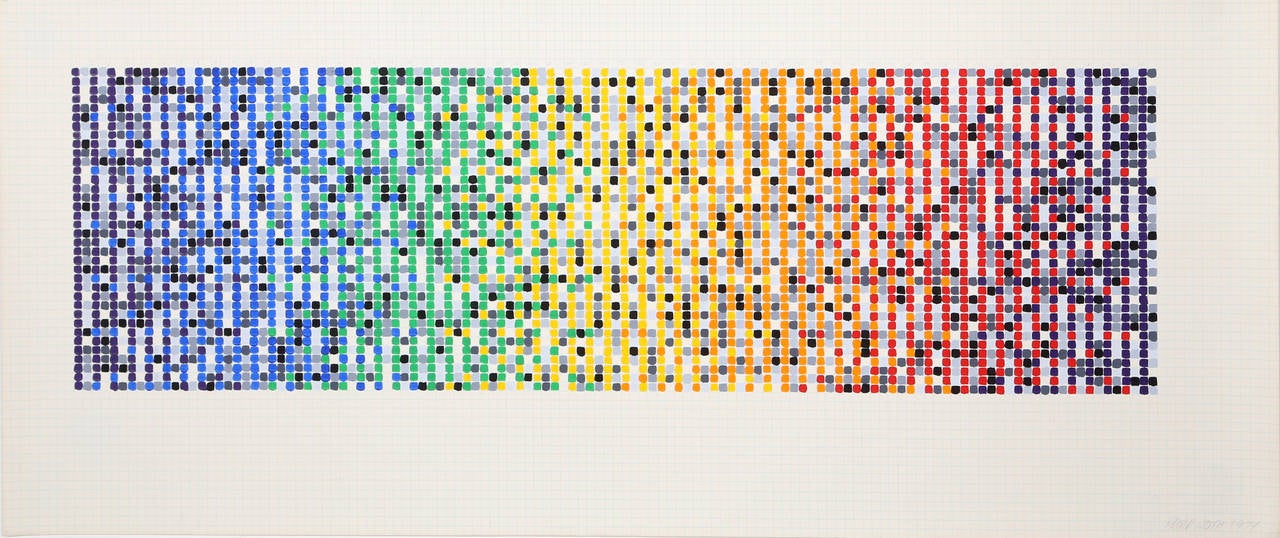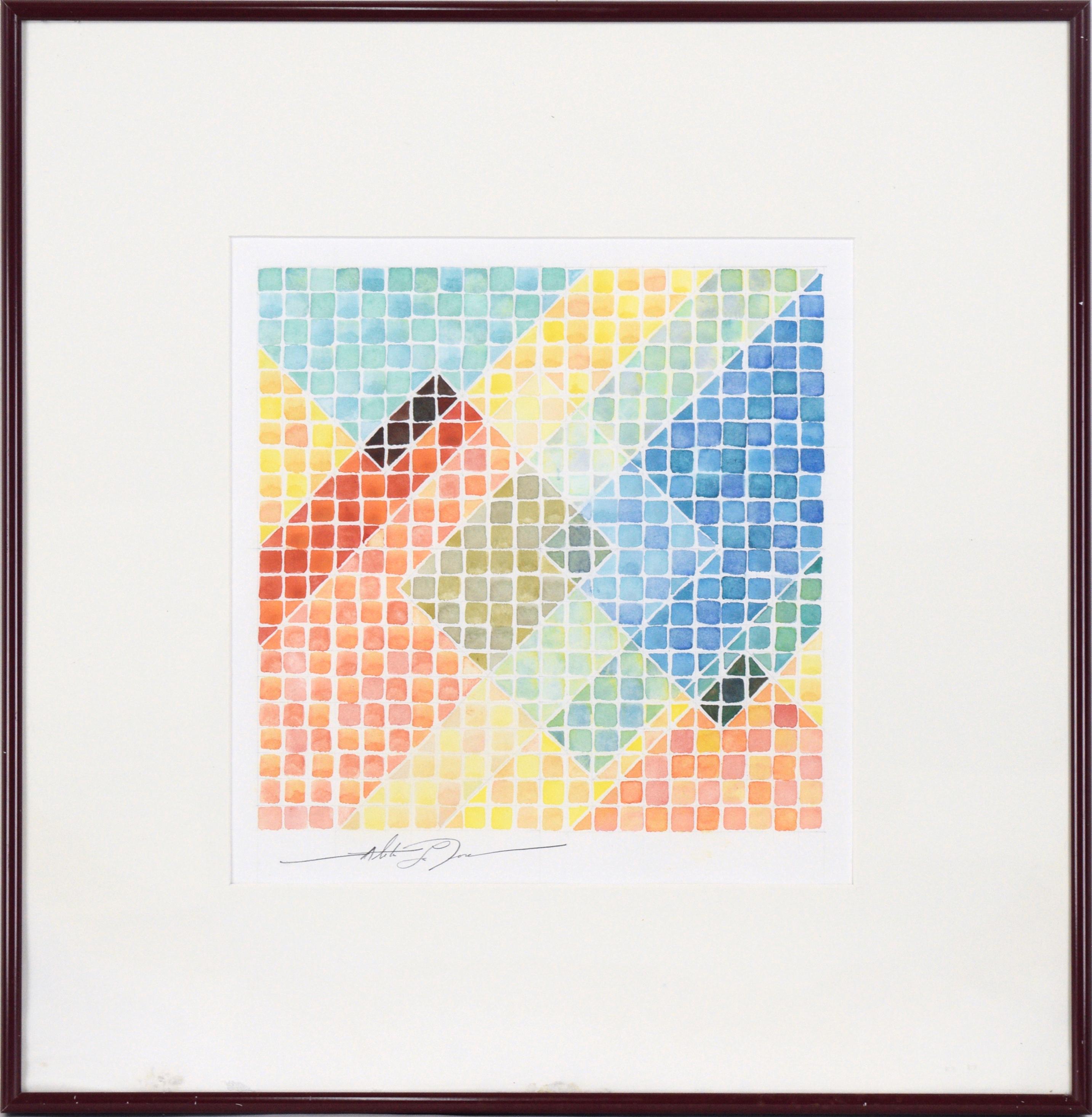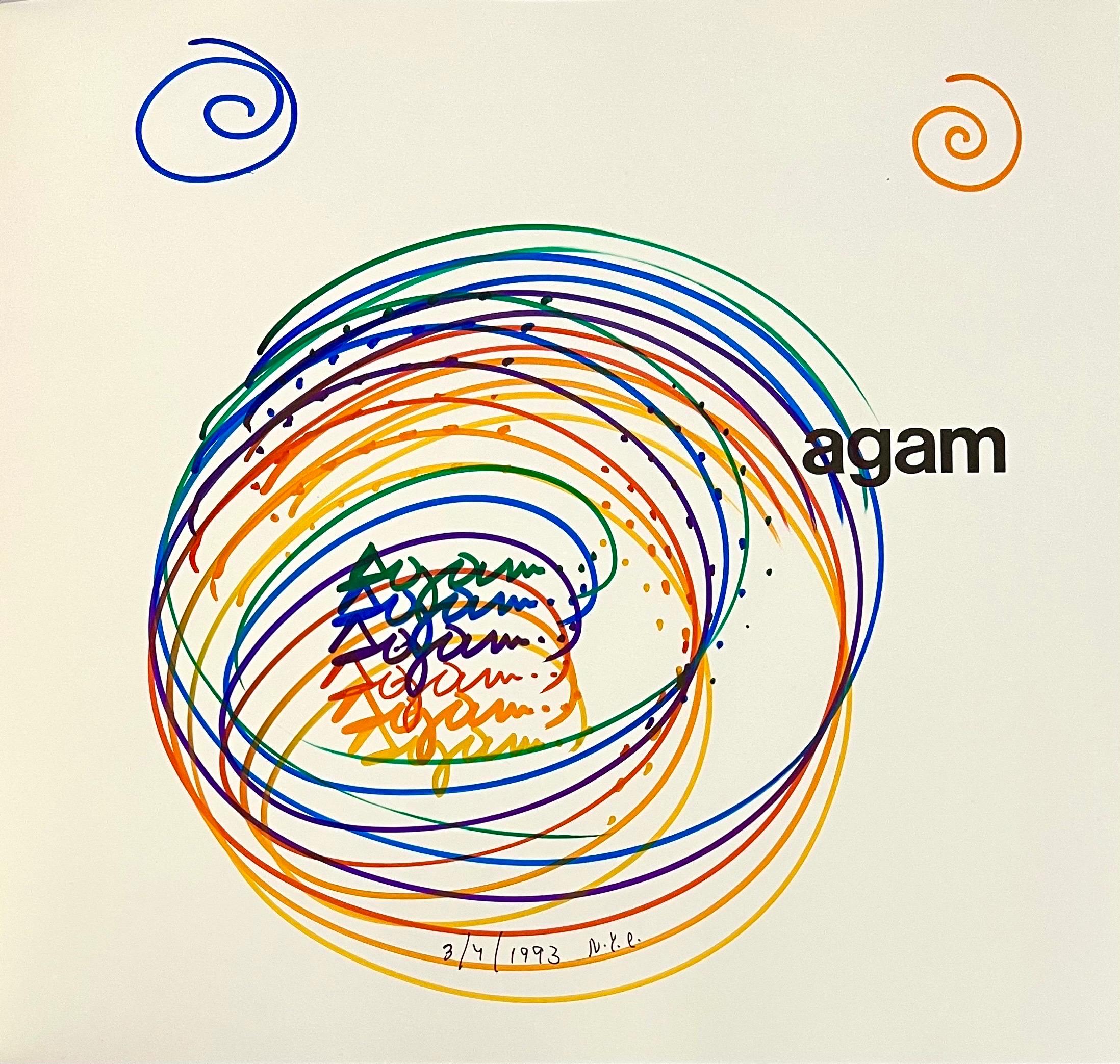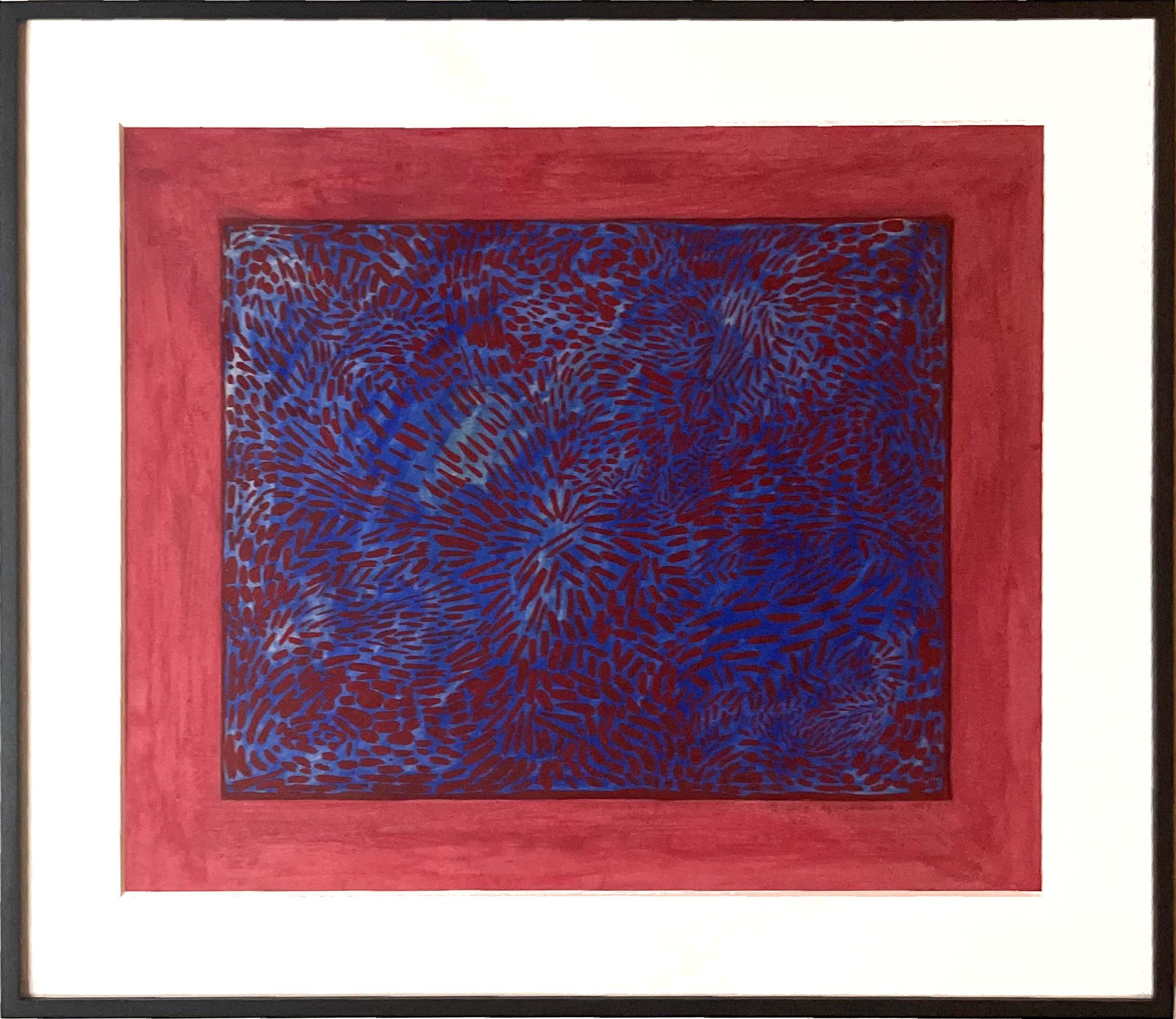Items Similar to "Staircases Falling Out, " Adrianne Wortzel, Blue and Gold Abstract Op Art
Want more images or videos?
Request additional images or videos from the seller
1 of 9
Adrianne Wortzel"Staircases Falling Out, " Adrianne Wortzel, Blue and Gold Abstract Op Art1987
1987
About the Item
Adrianne Wortzel (American, b. 1941)
Staircases Falling Out, 1987
Acrylic on paper
22 x 30 inches
Signed and titled on the reverse
Provenance:
Webb & Parsons, New Canaan, Connecticut, 1988
Reader's Digest Collection
Adrianne Wortzel creates unique and innovative interactive art works exploring historical and cultural perspectives by coupling fact and fiction and deploying their considered mix in both physical and virtual networked environments. Projects manifest as telerobotic performance productions, videos, art objects, writings and artist’s books.
Her works are often created in collaboration with research scientists and engineers both in the US and internationally. Her productions always employ narratives nascent to historical events and technological research in order to point to creative endeavors emerging from an armature of empirical knowledge. The content examines, or displays, through fictive and dramatic scenarios, stories and scripts, aspects of how humans relate to machines.
Her works have received financial and residency support from the National Science Foundation; Eyebeam Art and Technology Center; The Whitney Museum of American Art, the Swiss Artists-in-Labs Program; the Artificial Intelligence Laboratory; University of Zurich; The National Science Foundation; The Franklin Furnace Fund for Performance Art; the Greenwall Foundation; the New York State Council on the Arts; the Science and Art Research Collaborations in New Mexico; PSC-CUNY Research Foundation; and the Robert Rauschenberg Foundation. Her writing and articles have been published in numerous national and international publications.
Exhibition venues include the Whitney Museum of American Art commission of her interactive telerobotic piece Camouflage Town for the exhibition Data Dynamics as well as an online work for the Whitney’s Artport web site; StudioBlue@Citytech for Eliza Redux (a telerobotic work with three robots offering online psychoanalytic sessions: respectively implementing Freudian, Jungian, and Lacanian disciplines); 516Arts, Albuquerque, New Mexico, Abrons Art Center (Performa 09 Performance Art Biennial), New York; “Re-enactment of the Battle of the Pyramids” (toys meant for children reconfigured as instruments of war) at Eyebeam Art and Technology Center; Light Industries, New York; Extensions Between Body, Mind And Electronic Worlds, Naples, Italy; Lehman College Art Gallery and Lehman College Theater; Arreale99, Baitz, Germany; Ars Electronica, Linz, Austria; Creative Time Art at the Anchorage; MIT Vera List Center; Orlando Museum of Art; Moderna Museet, Stockholm, Sweden.
She is a Professor of Entertainment Technology and Emerging Media Technologies at New York City College of Technology, the senior technical college in the City University of New York (CUNY) system. Her keystone courses are Topics and Perspectives in Emerging Technologies and Narrative Design, both collaborative research and projects courses open to all disciplines at the College.
She is the Founding Director of StudioBlueLab, an interdisciplinary collaborative lab facility for faculty and student invention, established by a 2004 CUNY Graduate Research Technology Incentive Award and maintained at New York City College of Technology, originally funded as The Robotic Renaissance Project at the Cooper Union for the Advancement of Science and Art by a National Science Foundation 2001 Award as well as the Gateway Engineering Education Coalition at Cooper Union.
- Creator:Adrianne Wortzel (1941, American)
- Creation Year:1987
- Dimensions:Height: 27 in (68.58 cm)Width: 35 in (88.9 cm)
- Medium:
- Movement & Style:
- Period:
- Condition:Excellent.
- Gallery Location:New York, NY
- Reference Number:1stDibs: LU184129923632
About the Seller
5.0
Platinum Seller
These expertly vetted sellers are 1stDibs' most experienced sellers and are rated highest by our customers.
Established in 2021
1stDibs seller since 2022
61 sales on 1stDibs
Typical response time: 1 hour
- ShippingRetrieving quote...Ships From: Larchmont, NY
- Return PolicyA return for this item may be initiated within 3 days of delivery.
More From This SellerView All
- "Untitled, " Thiago Rocha Pitta, Brazilian Contemporary Grey WatercolorLocated in New York, NYThiago Rocha Pitta Untitled, 2006 Watercolor on paper 30 x 23 inches Brazil-based artist Thiago Rocha Pitta’s (b. 1980) temporal and sensitive body of work depicts interventions wit...Category
Early 2000s Contemporary Abstract Drawings and Watercolors
MaterialsPaper, Watercolor
- "Untitled, " Thiago Rocha Pitta, Contemporary Grey WatercolorLocated in New York, NYThiago Rocha Pitta Untitled, 2006 Watercolor on paper 30 x 23 inches Brazil-based artist Thiago Rocha Pitta’s (b. 1980) temporal and sensitive body of work depicts interventions wit...Category
Early 2000s Contemporary Abstract Drawings and Watercolors
MaterialsPaper, Watercolor
- "Repetition" Chryssa, Greek Female Artist, Abstract, Neon Light Art StudyBy Chryssa Vardea-MavromichaliLocated in New York, NYChryssa Repetition Signed lower right; titled on the reverse Gouache, watercolor, charcoal, and graphite on paper 15 x 11 inches Born and educated in Athens, Greece, Vardea Chryssa, known professionally as Chryssa, became a U.S. citizen and earned a reputation for her sculptured assemblages utilizing light from neon, and plexiglas combined with mixed media pieces. One of her pieces, Untitled Light Sculpture (1980) is 22 feet long and is installed in the atrium of a building at 33 Monroe Street in Chicago. It was programmed electronically to create changing patterns of reflected light through 900 feet of neon tubing. Chryssa's sculptures with precision and definite form were a reaction against the prevalent Abstract Expressionism of the 1950s with its emphasis purely upon the artist's intent. In her work, the focus is on materials and the way they are shaped for specific use by craftsmen. She got her early education in Athens, and first studied to be a social worker. She was then sent by the Greek Ministry of Social Welfare to the Dodecanese Islands and later to the Ionian Sea island of Zante, whose population had suffered great loss from earthquakes. Disillusioned that monies were being provided to restore monasteries but not to help other earthquake victims, Chryssa changed her life's direction to become a painter. In Athens, she studied art with Anghelos Prokopion. Then she went to Paris, France, and studied briefly at the Academie Grande Chaumiere and associated with surrealists Andre Breton, Edgard Varese, and Max Ernst. In 1954, she moved to San Francisco, California for a year of study at the California School of Fine Arts, and there she first saw the work of Jackson Pollock, which had a freeing affect on her and inspired her to experiment with pure form. But later she reacted against action painting with her assemblage sculptures of controlled precision. In 1955, Chryssa settled in New York City, and became the first artist to incorporate neon light tubing and commercial signs into sculpture. It is asserted that her "mature work grew out of the Greek experience, before and after World War II, wedded to the raucous letters, signs, symbols, and lights of Time Square, New York City" (Heller 125). In fact, she was so taken with the lights of Times Square that she unsuccessfully tried to get a job as a sign maker but was prevented by labor union rules. However, one of the members gave her sign-making lessons in his shop. She first made Pop images such as depictions of automobile tires and cigarettes and in sculptures, utilized letters of the alphabet, ideas that predated similar images by Jasper Johns and Andy Warhol. Her first major work of interwoven light and letters was Times Square Sky of 1962, but she was dissatisfied because she thought the piece was too crowded. To create a sense of breathing, she inserted neon light, and for the first time, this material became an art medium. From that time, she was prolific and created many variations based on the letters W and A. For her, a primary motivating factor was remaining cool or mentally collected amidst the onslaught of bombarding information and to process it through her creations in new ways so that nothing was repeated. She set up her own work place...Category
Late 20th Century Abstract Abstract Paintings
MaterialsGouache, Graphite, Paper, Charcoal, Watercolor
- "Rembrandt Later Danae, " Alan Fenton, Abstract ExpressionismLocated in New York, NYAlan Fenton (1927 - 2000) Rembrandt Later Danae, 1975 Watercolor on paper 23 x 17 inches Signed and dated lower right; titled lower left Fenton's quiet an...Category
1970s Abstract Expressionist Abstract Paintings
MaterialsPaper, Watercolor, Gouache
- "Colorful Geometric Abstraction, " Simon Samsonian, Armenian ArtistLocated in New York, NYSimon Samsonian (1912 - 2003) Colorful Geometric Abstraction, 1981 Oil on paper 16 x 22 inches Signed and dated lower right Provenance: Estate of the artist This survivor of the Armenian genocide wound up in a Cairo orphanage in 1927. He rose to fame as one of Egypt’s great modernists, but after moving to Long Island late in life he withdrew into anonymity. Now his compelling story is being told. Art historians are finally beginning to realize that the power of abstraction in its early years was a zeitgeist not limited to the major European centers of the avant-garde — Paris, Munich, and Moscow — but one that quickly rippled to major cities throughout the world. Within a few decades that original shock of a new vision had inspired thousands of artists from different cultures — particularly those the Middle East — whose translations were not slavish imitations of works by seminal figures like Picasso, Braque, Malevich, and Kandinsky but creative variants colored by their respective cultures. This essay focuses on an extraordinary Armenian artist, his harrowing survival of the genocide, his rise to fame in Cairo, and his creation of a unique style of abstraction. Art historians have typically formed a chorus that teaches the history of abstraction like this: Just before and during the World War I era, several avant-garde artists emerged to create shockingly different new forms by which artists could express themselves. In Paris, Picasso and Braque broke out with cubism, quickly followed by Mondrian. In Moscow, Malevich created Suprematism, the ultimate hard-edge geometric abstraction. And in Munich, Kandinsky emerged as the father of Abstract Expressionism. Within these few short years a zeitgeist was sensed throughout the art world. American pioneers, too — particularly Stanton Macdonald-Wright and Morgan Russell — felt this explosive freedom of expression. When Europe was recovering after World War I it became clear that Paris would retain its title as capitol of the art world, lasting through the Roaring Twenties and even through the Great Depression. But the end of World War II changed everything. A parallel war had been won by a group of irascible young Abstract Expressionists in New York — led by Pollock, Rothko, DeKooning, and Kline. No sooner had Paris been liberated from the Germans than Picasso, Matisse, Breton, and Duchamp surrendered to the Americans. From that point on New York would be the epicenter of the art world. But a lens that focuses myopically on the war between the avant-garde of Paris and New York misses the wider narrative of multiple aesthetic modernities that developed in the several decades following World War I. For Armenian artists the matter is even more complex owing to the genocide of 1915 where more than 1.5 million people — seventy-five percent of Armenians in the Ottoman Empire — were massacred. Those not shot on the spot were sent on death marches through the Mesopotamian desert without food or water. Frequently, the marchers were stripped and forced to walk naked under the scorching sun until they dropped dead. As a child Samsonian witnessed the murder of his parents and most of the members of his family. Soon thereafter, his older sister, Anahid, quickly shepherded him into a line of children being rescued by Greek nuns. But they became separated and he lost her, too. He was sent to a Greek orphanage in Smyrna (now Izmir), on Turkey’s west coast. Because he only knew his first name, the orphanage gave him a last name based on the place where they found him — Samsun — a major port on Turkey’s north coast on the Black Sea. His birth date was unknown, too. According to Samsonian’s vague recollections he assumed he was about three or four years old at the onset of the genocide, which would place his birth year in 1911 or 1912. In 1922, when Samsonian was about 10, the Turks ended their war with the Greeks by putting Smyrna to the torch in what has been called the “Catastrophe of Smyrna.” Once again, the child was on the run, escaping the fire and slaughter. He found temporary refuge in Constantinople, but within a year that major port would fall to the Turks, too, and become renamed as Istanbul. This time, Samsonian was whisked away to an orphanage in Greece founded by the American charity, Near East Relief — which is credited with saving so many Armenian orphans that the American historian Howard M. Sachar said it “quite literally kept an entire nation alive. Any understanding of Samsonian’s approach to modernism requires careful consideration of the impact of his early years because his art is inseparable from the anguish he experienced. In 1927, when he was a teenager, he was transferred to Cairo, Egypt, then a cosmopolitan city hosting a sizable portion of the Armenian diaspora. There he lived with thirty-two other children on the top floor of the Kalousdian Armenian School. Upon graduating in 1932 he won a scholarship to attend the Leonardo da Vinci Art Institute — an Italian art school in Cairo — where he won first prize in final examinations among one hundred students. He found work with an Armenian lithographic printer and he returned to the Kalousdian Armenian School to teach drawing. In 1939 he married one of his students, Lucy Guendimian. The Cairo in which Samsonian matured as an artist was home to many prominent art collectors after World War I. In this receptive environment Samsonian exhibited widely and won many awards. Beginning in 1937 and for the next thirty years he exhibited annually at the prestigious Le Salon du Caire hosted by the Société les Amis de l’Art (founded in 1921). After World War II he hit his stride as a modernist in Cairo, counting among his peers other artists of the Armenian diaspora such as Onnig Avedissian, Achod Zorian, Gregoire Meguerdichian, Hagop Hagopian...Category
1980s Abstract Geometric Abstract Drawings and Watercolors
MaterialsPaper, Oil
- "Inherent Light Series IX, " Alan Fenton, Abstract Expressionism, Black StripesLocated in New York, NYAlan Fenton (1927 - 2000) Inherent Light Series IX, 1977 Watercolor on paper 23 x 17 inches Signed and dated lower right; titled lower left Fenton's quiet and contemplative nonobjec...Category
1970s Abstract Expressionist Abstract Paintings
MaterialsPaper, Watercolor
You May Also Like
- Untitled VI, Acrylic Painting on Paper by David RothBy David RothLocated in Long Island City, NYArtist: David Roth, American (1942 - ) Title: Untitled VI Year: 1974 Medium: Acrylic Painting on Arches Paper, signed and dated Image Size: 15.5 x 45.5 inches Size: 22.5 in. x 53.5 i...Category
1970s Op Art Abstract Drawings and Watercolors
MaterialsAcrylic
- Geometric Color Grid - Op Art CompositionLocated in Soquel, CAHighly precise op-art composition by an unknown artist. A grid of colored squares has been created with various colors, divided by occasional diagonal lines that give the feel of ove...Category
21st Century and Contemporary Op Art Abstract Drawings and Watercolors
MaterialsPaper, Watercolor
- Agam Original Marker Drawing Colorful Spirals Hand Signed Israeli Kinetic Op ArtBy Yaacov AgamLocated in Surfside, FLYaacov Agam, Israeli (b. 1928) Hand signed and dated This is a great example of bold, graphic, mod design. Along with Reuven Rubin and Menashe Kadishman he is among Israel's best kn...Category
1990s Op Art Abstract Drawings and Watercolors
MaterialsArchival Paper, Permanent Marker
- UntitledBy John KalymniosLocated in White Plains, NY'Untitled' by John Kalymnios, 1999. Pantone ink on paper, 78.5 x 51.25 in. (framed). This geometric op art drawing features bands of concentric circles with the full spectrum colors ...Category
1990s Op Art Abstract Drawings and Watercolors
MaterialsInk, Archival Paper
- David Roth, Abstract Drawing, 1977By David RothLocated in Long Island City, NYThis colored pencil drawing was created by American artist David Roth. Roth's images are proportioned according to a strict mathematical formula - the pictures are composed according...Category
1970s Op Art Abstract Drawings and Watercolors
MaterialsPaper, Color Pencil
- Near and Far Acuity, Mid Century Modern Op Art painting from historic exhibitionBy Richard AnuszkiewiczLocated in New York, NYRichard Anuszkiewicz Near and Far Acuity, 1957 Gouache and watercolor painting Hand signed and dated 1957 by Richard Anuszkiewicz on the right front Frame included Anuszkiewicz' artworks from the late 1950s are rarely found on the market. This historic painting is one of the works that helped launch the artist's career. It was done in 1957 - the year the artist arrived in New York. Near and Far Acuity has been removed from its original frame, and re-framed in an elegant wood frame with conservation materials and UV plexiglass. The original gallery label from The Contemporaries has been preserved and affixed to the new backing, and the collector who acquires this work will also be provided with a copy of the original receipt - signed by Karl Lunde (director of the Contemporaries and author of a major monograph on the artist). Measurements: Frame: 32 x 28 x 2 inches Artwork: 21 x 25 inches This work was first exhibited in the groundbreaking, and career-making 1960 exhibition at The Contemporaries gallery (New York, February 29, 1960 - March 19, 1960) and was featured in the exhibition catalogue, shown in the images here. In his essay entitled "Richard Anuszkiewicz: Color Precisionist" by art historian John T. Spike, he writes, "In the spring of '57, Richard Anuszkiewicz left Ohio for good. "I was ready. I came to New York with a substantial amount of work. I was ready to go around to the galleries and I was prepared because I really had something. I had an idea. I had a series of paintings that showed this idea and I felt good about it and I felt now that's the only place for me to be." A friend helped him get a job touching up the plaster models of classical temples and statues in the Junior Museum of the Metropolitan Museum of Art. He took off six months the next year to travel around Europe in a Volkswagen, also seeing some places in North Africa. "When I came back, I remember taking my work around to the galleries and receiving interesting comments — positive comments from the various people. But Abstract Expressionism was very popular. My things were very hard-edged, very strong in color — a use of color that nobody was using. Everybody would say. 'Oh, they are nice, but so hard to look at. They hurt my eyes". Leo Castelli considered him seriously but the gallery was developing a specialization in pop artists like Jasper Johns and Robert Rauschenberg. "I can remember going to Martha Jackson and having her look at the work and she would put her hands straight out in front of her and block out parts of the painting with her hand and she'd say, mmm no rest areas." He finally caught on with The Contemporaries Gallery in the fall of 1959. The gallery at 992 Madison Avenue mainly represented new European talent. Karl Lunde, the gallery director, saw some of his canvases hanging...Category
1950s Op Art Abstract Drawings and Watercolors
MaterialsWatercolor, Gouache, Mixed Media




